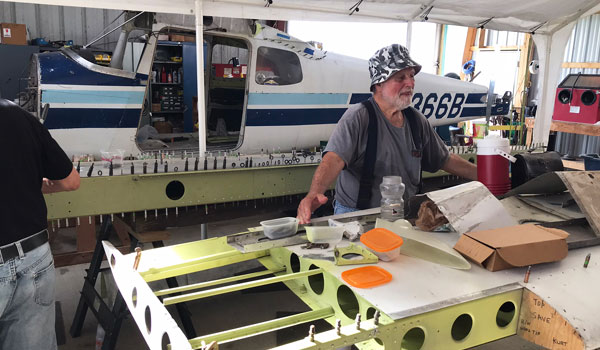
By Bob McDaniel, EAA 294523
In 2014, a small group of aviators from EAA Chapter 64 in St. Louis formed AeroCareers, a tax-exempt not-for-profit corporation for the purpose of aviation career education, networking, and mentoring. The founding directors include retired airline, military, NASA, and traffic watch pilots; an airport director, an aircraft maintenance business owner; the president of the local air and space museum; and an air traffic controller who often works traffic at AirVenture and SUN ‘n FUN.
They began working with youth groups, school teachers, and a variety of other aviation organizations, businesses, and colleges to help people find pathways to aerospace careers. As the organization grew, the mission expanded to include a very low-cost flying club that enabled teenagers to obtain their pilot certificates and rusty pilots to get back into the cockpit using the club’s vintage Cessna 172.
Volunteers from both AeroCareers and Chapter 64 are working together to restore a first-generation 1957 Cessna 172 that was destroyed in a Florida hurricane, meeting weekly to learn and practice aircraft maintenance and repair skills. Once completed, this long-term project will be used as a conventional gear trainer for the flying club.
AeroCareers’ latest project is restoring a very unique and historic aircraft known as The New Spirit of St. Louis. N142LC is the third and only surviving Lancair Columbia 300 prototype and was flown non-stop from New York to Paris in May 2002 by Charles Lindbergh’s grandson, Erik, EAA 672161, as he retraced his grandfather’s historic transatlantic flight on its 75th anniversary.
The aircraft was originally built in 1998 by Pacific Aviation Composites US, a company formed to transform Lancair’s line of kitbuilt aircraft into the type-certified production market. For the next three years, N142LC completed the Columbia flight test and production certification program and logged more than 900 hours promoting the Columbia 300 as the only flying prototype.
In December 2001, the aircraft returned to the factory to be retrofitted with an auxiliary fuel tank and a custom Lancair 400 wing designed to carry the additional fuel needed for Erik’s transatlantic flight. After completing the flight in only 17 hours and 7 minutes, approximately half the time of his grandfather’s flight, the aircraft returned to the Lancair factory for removal of the large ferry fuel tank and installation of a complete, factory production interior.
Over the next three years, the aircraft made flights around the country promoting the Lindbergh Foundation, the X-Prize, and other sponsors. Although there were various plans for displaying the aircraft and flying it for educational purposes, none came to fruition and the aircraft disappeared into the back corner of a private storage hangar for the next 14 years.
AeroCareers acquired the aircraft in May 2022 and immediately began efforts to return it to the air to fly educational and promotional missions including Young Eagles and Eagle flights.
Although the aircraft remains in near pristine condition, the restoration won’t be quick, easy, or inexpensive. Various parts and supplies have been ordered, including a new battery, tires, tubes, hoses, door lift-struts, belts, seals, and other rubber components that must be replaced due to age and disuse. Also, in addition to updating the systems’ databases, ADS-B will have to be installed to meet current requirements.
Although the aircraft’s first public appearance occurred in June as a static display for the Illinois Mathematics and Science Academy’s 5th to 12th Grade Educators Aviation Day, it will be several months before its first flight, primarily due to FAA backlogs. Because the aircraft was deregistered, the FAA Aircraft Records Branch must first reassign the aircraft’s tail number and there is a five-month backlog of work before the registration application will reach the top of their in-basket. The registration must be completed before obtaining a new airworthiness certificate and operating limitations from the flight standards district office, and they also have several months of backlogged work. The aircraft should be ready to fly long before the paperwork is completed.
Because the aircraft was built in the factory but not from an approved production line, it is neither a certified nor an amateur-built aircraft. It can only be registered as an experimental exhibition aircraft with more restrictive use limitations than the more common experimental amateur-built aircraft many of us fly. It is authorized to fly passengers, including Young Eagles and other introductory flights, and can travel to distant locations, but the FAA must be notified where it will be flown each year in a program letter.
For more information about AeroCareers or The New Spirit of St. Louis, go to www.aerocareers.org or follow the restoration progress at Facebook.com/AeroCareersNFP.
Look for the aircraft at AirVenture Oshkosh, SUN ‘n FUN, and other aviation gatherings in 2023!




